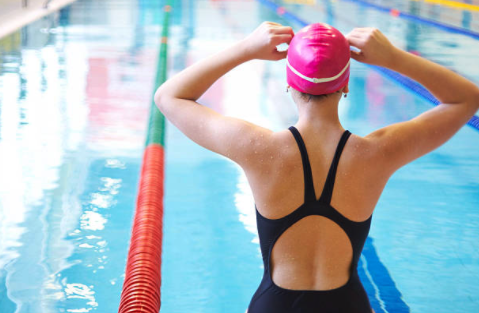Swimming is an excellent activity for people of all ages. It can be a lifelong sport and a great way to stay fit. Kids can swim at a recreational level or as part of a competitive team. The most common complication for swimmers is shoulder pain. About 65% of competitive swimmers will experience a problem with their shoulders at some point. The shoulder is a very mobile joint—which makes it great for overhead sports like swimming but can also lead to pain and problems.
If your young swimmer starts to complain of shoulder pain, it’s important to pay close attention to the complaints to determine if it’s simple muscle soreness or something more serious. Pain that starts late into practice and resolves quickly may simply be fatigue and soreness. Pain that is persistent throughout practice and is starting to cause pain in daily activities (reaching overhead, brushing hair etc.) is never normal. If your son or daughter has issues with decreased motion of the shoulder or weakness, this is also a sign of something more serious. If this becomes a concern, please have your child stop swimming and be evaluated by a doctor before returning. Your physician may prescribe physical therapy, rest from swimming, or alteration in swim practice including focusing on different strokes or simply kicking with a kickboard.
As a parent, and an athlete, the biggest question is, can this be prevented? To some extent, it can.
Here are some tips to help keep your swimmer healthy and in the pool:
- Participate in a well-supervised strengthening program—Doing some extra strengthening of the small rotator cuff muscles and the shoulder blade can be beneficial. Often termed “dry land” workout by swimmers, these exercises targeting the small shoulder muscles can help maintain shoulder stability. There is no need to use big heavy weights! Stretch bands and small 1-3 lb weights are all that you need to strengthen.
- Ensure proper technique—Be sure that all stroke techniques are correct. Incorrect arm positioning during strokes or improper body roll can place pressure on vulnerable areas of the shoulder leading to pain and injury. Coaches should always be monitoring form during practice.
- Monitor yardage—Some swimmers can average 10,000 yards per practice! Imagine the number of rotations the shoulder is going through during that time. Even with the best form, overuse shoulder pain can occur as a result of too much swimming. Swimmers should build up yardage slowly leading into the season and if pain or fatigue is setting in, alterations and decreases will need to be made.
The most important point is don’t ignore the pain! Pushing through excessive shoulder pain will make recovery that much more difficult. If pain is persistent, be evaluated so that changes can be made to strokes and training regimen to keep your swimmer healthy and in the water.






Comments